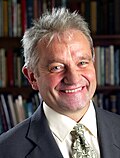Francis Crick Institute
The Francis Crick Institute is a biomedical research centre in London which opened in 2016.[1][2] It is a partnership between Cancer Research UK, Imperial College London, King's College London (KCL), the Medical Research Council, University College London (UCL) and the Wellcome Trust.[3]
 The Francis Crick Institute | |
| Type | Research institute |
|---|---|
| Registration No. | England and Wales: 1140062 |
| Headquarters | 1 Midland Road, London NW1 1AT, United Kingdom |
| Coordinates | 51°31′53″N 0°07′44″W / 51.5315°N 0.1289°WCoordinates: 51°31′53″N 0°07′44″W / 51.5315°N 0.1289°W |
| Focus | Medical research |
| Website | crick |
The institute has 1,500 staff, including 1,250 scientists, and an annual budget of over £100 million,[4] making it the biggest single biomedical laboratory in Europe.[1]
The Institute includes the former UK Centre for Medical Research and Innovation, which was at Mill Hill, North London.
The institute is named after the British molecular biologist, biophysicist, and neuroscientist Francis Crick, co-discoverer of the structure of DNA. Crick shared the 1962 Nobel Prize in Physiology or Medicine with James Watson and Maurice Wilkins. Unofficially, the Crick has been called Sir Paul's Cathedral, a reference to its Director, Sir Paul Nurse, and St Paul's Cathedral.[5]
Francis Crick Institute Media
Francis Crick (above) and James Watson were two Cambridge scholars who created the first double-helix model of DNA and are the "fathers of modern genetics".
Paul Nurse, director and chief executive of the Institute since 2011
References
- ↑ 1.0 1.1 Jha, Alok; correspondent, science (2010-06-19). "Plans for largest biomedical research facility in Europe unveiled" (in en-GB). The Guardian. . https://www.theguardian.com/science/2010/jun/19/largest-biomedical-research-facility-europe. Retrieved 2019-08-08.
- ↑ Walsh, Fergus (1 September 2016). "The Crick: Europe's biggest biomedical lab opens". BBC News. https://www.bbc.co.uk/news/health-37246994.
- ↑ Three's company: Imperial, King's join UCL in £700m medical project. Times Higher Education. 15 April 2011. http://www.timeshighereducation.co.uk/story.asp?sectioncode=26&storycode=415855&c=1. Retrieved 16 April 2011.
- ↑ "Unprecedented Step | UKCMRI". 11 September 2010. Archived from the original on 11 September 2010. Retrieved 8 August 2019.
- ↑ Callaway, Ewen (2015). "Europe's superlab: Sir Paul's cathedral". Nature. 522 (7557): 406–408. Bibcode:2015Natur.522..406C. doi:10.1038/522406a. PMID 26108834. S2CID 4460403.


